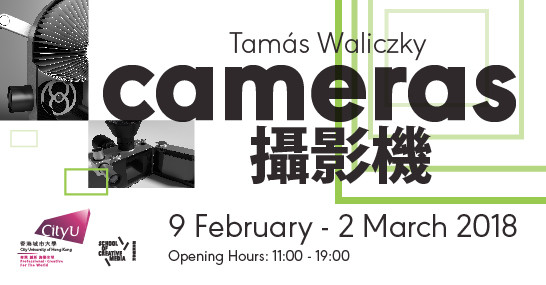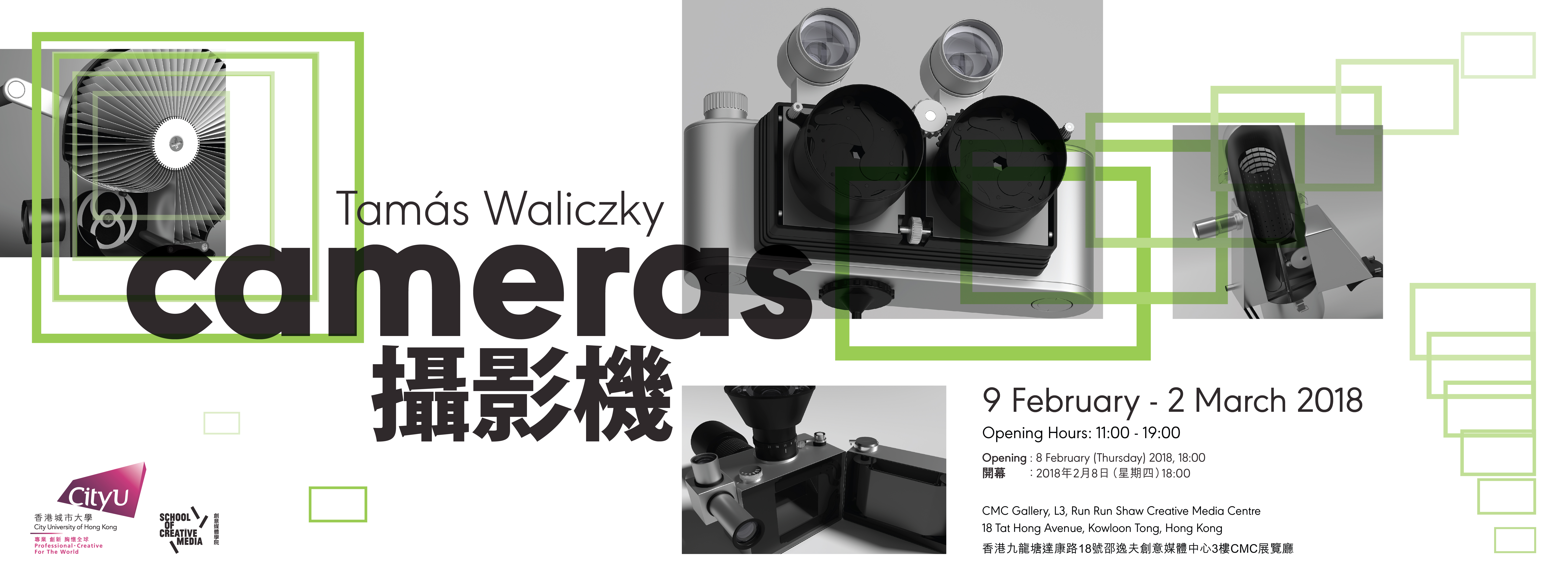Tamás Waliczky | CAMERAS | Exhibition
Exhibition
08 Feb
02 Mar 2018
11:00am - 07:00pm
CMC Gallery, L3, Run Run Shaw Creative Media Centre
|

|
Curator: Anna Szepesi
CMC Gallery, L3, Run Run Shaw Creative Media Centre
Exhibition period: 9 February - 2 March 2018, 11:00 - 19:00
Opening: 8 February (Thursday) 2018, 18:00
Opening speech by Jeffrey Shaw
Guided tours with the artist: 10 February (Saturday), 14:
Artist talk: 2 March (Friday), 18:00
Tamás Waliczky's latest work, “Cameras” (2017), is a series of computer-rendered 3-D graphic works, in which he has created imaginary devices based on the set-up of both the photo camera and the movie camera, following from the idea of Vilém Flusser, according to whom the camera – unlike other tools – is not necessarily a prosthetic extension of the human body, but rather a plaything, allowing the photographer to become the player.
As a new media artist, Waliczky also deals with the origins of his chosen medium. His digital print series consists of fantasy equipment invented by him. Cameras are the basis of media art and new media art: optical-media machines that for the first time, imitated the very act of seeing. They are designed by people; hence, these devices tell a lot about how humans see, and how they picture the world visually, and have indeed significantly changed how we see our world.
Waliczky’s inventions do not exist in reality. Although their structures are based on actual cameras, similar devices, inventions or long forgotten 19th-century designs, their technical aspects have all been re-engineered by the artist. Humour and irony are also part of his imaginary cameras, which are clumsy, cumbersome creations and would be rather hard to use, as well as making weird noises.
The technological developments of photography follow the ideologies of mass-production, user friendliness and compatibility. Anyone can take sharp, colour-corrected photos without any experience. The cameras of Waliczky’s series pursue an alternative route of innovation. They are unique creations and not standardised objects: using these cameras requires special skills and sensitivity. The artist inspires the audience’s imagination to look at image-making as an intimate and playful act.
Conversation on the “Cameras” series (excerpt)
Anna Szepesi: You have undergone a shift in genres. You are producing a printed graphic series of 3D models, and the final products appear not on monitors or a projection screen, but rather on paper. Why do you feel that these graphic works are important right now? What do these anthropomorphic machines mean to you?
Tamás Waliczky: I didn’t make a conscious decision, but rather I have been trying for about a year with all kinds of other work, but I didn’t like any of them. And then I thought of this, and I liked it. This might seem to be a new genre in comparison with what I have been doing in recent years, but you know precisely that in 1989, thirty-something years ago, I made a graphic series, entitled Machines. So I would rather say that I returned to an earlier genre, which I really loved at the time. I began to produce this series with my unusual childhood in mind. As my father was an amateur photographer, our flat was filled with the catalogues of photo-machines. In my childhood, alongside the stories familiar to everyone, I scanned these catalogues, and I dreamed of how great it would be if I could have this or that camera. I am versed in this language, because there is also a language for this: shutter-speed, the diaphragm, the lenses. Even though I am not a photographic mechanic or technician, I grew up with this language, and it means something to me. This is my personal thread to these images. Throughout my entire life, in all of my works, I have been interested in how man sees. My works, The Garden, and Sculptures, address how we see, how we perceive reality. These machines are anthropomorphic to the extent – if at all – that they show the various modes of vision – that we can see the world in this way or that way. And this is shown a bit ironically, even awkwardly, in the form of these machines made of metal. These are cameras that do not exist, but they might have been invented, if the development of photography had taken a different direction. Thus, this is an alternative developmental path. I am very interested and engaged in this recently. It is a bit of the history of photography, a bit of how man sees, and also my relationship to my childhood experiences: this is what provided the foundation for this series, and what I am still engaged in.
Exhibited works:
Prints: Flipbook Camera, Flipbook Projector, Stereo Camera, Glass Plate Camera, Spiral Camera, Orthographic Camera, Swivel Camera, Muybridge Camera, Multiple Exposure Camera, Beam Splitter Camera, Zoetrope Camera, Clockwork Camera, Camera for Abstract Film, Mirror Camera, Panorama Camera
Animations: Panorama Camera, Swivel Camera, Flipbook Projector
The entire Cameras series will be on view in September 2018 at the Lumenvisum Gallery (L2-10, JCCAC, Shek Kip Mei, Hong Kong), accompanied by a detailed catalogue.

策展人:Anna Szepesi
邵逸夫創意媒體中心3樓CMC展覽廳
展覽日期:2018年2月9日至3月2日 11:00-19:00
開幕:2018年2月8日(星期四) 18:00
藝術家導賞:2月10日(星期六) 11:00 , 2月24日(星期六) 11:00
藝術家講座:3月2日(星期五) 18:00
Tamás Waliczky的最新作品《攝影機》(2017) 是一系列的三維電腦圖像作品,以相機和電影攝影機作為藍本,想像出不同的器材。這系列作品的意念源自Vilém Flusser,他提出攝影機不同於其他工具,並非人的肢體的延伸,而是一種玩具,讓攝影師變成玩家。
作為新媒體藝術家,Waliczky藉此作品探索他自身的媒體的起源,這系列的數碼圖像作品以他想像出來的器材為題材。攝影機是媒體及新媒體藝術的基礎,是第一批能模擬人類視點的視覺媒體機器。這些機器由人設計,故能展示出人類如何觀察及怎樣透過視覺洞悉世界,攝影機也改變我們如何觀看這世界。
Waliczky所「發明」的攝影機並不實際存在,雖然是依據現實攝影機的結構、類似的器材及發明,與及早已被遺忘的19世紀設計而繪製,但作者完全重新思考其技術部份。這些想像出來的攝影機充滿幽默與反諷,它們笨重及難於操作,也會發出奇怪的聲音。
攝影的技術發展與大量生產、便於使用及兼容的意識形態息息相關。任何沒有攝影經驗的人都可以拍攝出色彩鮮明的照片,但Waliczky發明的這系列相機則走另類的創新路線,是獨一無二的藝術品而不是標準化的產品;使用這些相機需要特殊的技巧和敏感度。藝術家試圖激發觀眾的想像力,把影像製作視為個人化及具玩味性的行為。
關於《攝影機》系列的對談(節錄)
Anna Szepesi: 你改變了你的創作媒體,製作出三維圖像模型,最終的作品不是用屏幕或投影機展出而是印在紙上,為何你認為此時此刻這些圖像是重要的?這些擬人化器材對你來說有何意義?
Tamás Waliczky: 我沒有刻意的改變,過去一年我一直嘗試創作不同形式的作品,但最終都不喜歡,然後我想出這個我喜歡的作品。雖然這系列作品與我近年的創作相比是新嘗試,但其實早在三十多年前,即1989年,當時我已創作過一輯圖像系列作品,名為《機械》,所以你可說我回歸這個我曾經深愛的媒體。這作品的背後是我不尋常的童年,我父親是業餘攝影師,家裡盡是相機產品目錄。小時候除了看大家都熟悉的故事書外,我也看這些目錄,並夢想有一天擁有這個或那個相機。我對這些產品目錄的語言—它們有其獨特的語言—耳熟能詳:包括快門速度、快門、鏡頭等。雖然我不是相機工匠,但因自小接觸,這種語言對我來說繞有意義,是我個人對此題材的連繫。我一生創作的所有作品,或多或少都與人們如何觀看事物有關,比如《花園—廿一世紀業餘電影》及《雕塑 (時間 / 空間) 》是關於我們如何觀察和洞悉現實。這作品中的攝影器材某程度是擬人化,展示出不同的視覺形式與及揭露我們觀察這世界的方法。作品展示的這些金屬機器,帶有反諷甚至笨拙的意味,這些相機並不存在,但若攝影的發展稍有不同,便可能產生這些發明,所以這是另類的發展路向。我最近對此深感興趣,這次展覽背後的基礎,與攝影史、人們如何觀看世界及我的童年經驗多少有一點兒關係,目前我仍向著這方面積極探索。
展覽作品:
作品:翻頁相機、翻頁投影機、新歷聲相機、玻璃片相機、螺旋相機、正視相機、旋轉相機、邁布里奇相機、多重曝光相機、分束相機、西洋镜相機、發條相機、抽象電影攝影機、鏡子相機、全景相機
動畫:全景相機、旋轉相機、翻頁投影機
此系列作品亦將會在2018年9月於光影作坊展覽 (地址:九龍石硤尾白田街30號賽馬會創意藝術中心二樓十室),並出版更詳盡的作品目錄。